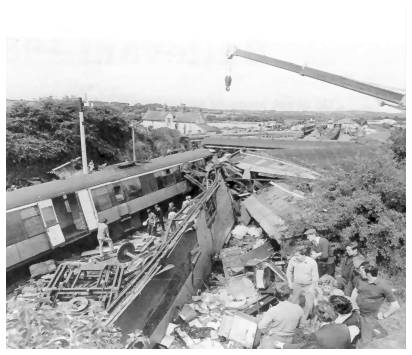One of Ireland’s worst ever rail disasters, and the deadliest since World War Two, happened on Friday August 1st, 1980.
Eighteen people were killed and more than 70 injured when a temporary set of points was left in the wrong position, sending an express train off the main line and into a siding where it derailed, crushing several carriages.
 The accident happened at Buttevant Railway Station in County Cork, on the main Dublin to Cork line. The 10am express train from Dublin was 187 miles into its journey when it entered Buttevant Station at 12-45pm, carrying around 230 bank holiday passengers.
The accident happened at Buttevant Railway Station in County Cork, on the main Dublin to Cork line. The 10am express train from Dublin was 187 miles into its journey when it entered Buttevant Station at 12-45pm, carrying around 230 bank holiday passengers.
About four months previously a set of manually-operated points had been installed to divert trains into a siding at the station as part of general maintenance and upgrading work. The crew operating the points were expecting a locomotive already in the station to be moved into the siding, so set the points to do that, unaware that the Dublin to Cork express train was imminent.
The crew should have obtained permission from the signalman before changing the points, but failed to do so. Because the temporary points were not connected to the signal box, the signalman was not immediately aware of what had happened. As soon as he realised, he set the warning signs at the approach to the station to ‘Danger’ and sent a message to change the points back, but it was already too late.
Travelling at around 60mph, the express train could not stop in time, hitting the wrongly-set points and lurching suddenly into the low-speed siding. Although the heavy diesel-electric locomotive remained upright, the lighter guards van and carriages immediately behind it jack-knifed and were thrown across four sets of tracks. The sudden halt of the loco meant the carriages behind it were compressed and crushed by their own momentum in what is known as the ‘accordion effect’.
To make matters worse, the leading four coaches – the First Class carriage, buffet car, self-service car and the first standard carriage – were all older wooden-bodied models which were destroyed in the pile-up. Carriages further down the train, with light alloy frames, were badly damaged but not destroyed, while the last three carriages, including the brake van, sustained only minimal damage.
The passengers who were killed or most severely injured were in the leading wooden carriages, which were incapable of surviving a high-speed crash. One of the first people on the scene was a local doctor, Finbarr Kennedy, who had been waiting to cross the line when the accident happened. He was able to treat some of the worst injured before emergency service personnel began to arrive.
The Buttevant disaster was followed just three years later by another major rail accident, at Cherryville Junction in County Kildare, which left seven dead and 55 injured. Between them, these two accidents accounted for 70% of all Irish rail deaths in a 28-year period, leading to strong public pressure for improved safety and more modern rolling stock.
A major national review of railway safety in Ireland resulted in the scrapping of wooden-bodied carriages, which came nowhere near the safety standards of post-1950s metal-body coaches. Experts studying the disasters found that under the enormous compression of a high-speed train crash, each carriage in the train could ‘ride up’ onto the one in front of it. The heavy steel chassis and wheels of the older carriages remained intact, but served as battering rams, completely smashing the inadequate wooden bodies which housed the passengers. Between 1983 and 1989, all of Ireland’s timber-bodied carriages were removed from service and replaced with modern steel-framed carriages.
In 2005 a special commemoration was held at Buttevant Railway Station to mark the 25th anniversary of the disaster. A bronze sculpture was unveiled alongside a plaque listing the names of the 18 victims.
